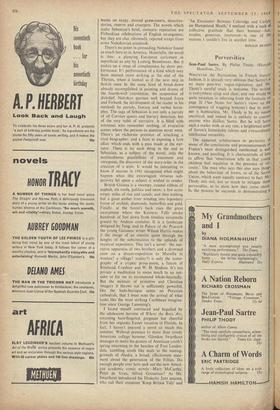Quest for Sebastian
The Real Life of Sebastian Knight. By Vladimir Nabokov. (Wcidenfeld and Nicolson, I5s.) Where the Boys Are. By Glendon Swarthout. (Heinemann, 16s.) Where the Boys Are. By Glendon Swarthout. (Heinemann, 16s.) IT would be fascinating, if one had them, to rummage through the yellow numbers of Horizon and the dwindled war-time weeklies to discover what they said when the first, scanty edition of The Real Life of Sebastian Knight appeared here in 1941. Did anyone, amid the raids and Russian communiquds, detect a his- toric event of another kind, and hang out a utility brown-paper garland for Vladimir Nabokov's debut in English? Did anyone, making a note to pursue the matter in calmer times, detect the arrival of a large talent spreading his exotic wares on a new shore? The Real Life is the most interesting of the early novels to which the success of Lolita has brought ex- humation, for it is the kind of piece an eighteenth- century painter might have shown to introduce himself at a new court : a glimpse into his studio, with a profile self-portrait and hints of autobiography, exhibiting a miniature selection of characteristic subjects on the walls, and splashing manner all over the place. In a gesture to his new language, it is about England : a fantasia, its flattery set on satiric edge by its tones of emigre excess, on memories of his first home-from-home after fleeing Russia. `I am
Sebastian,' declares the Russian half-brother who has explored the dead writer's life and grafted it on his own; but so also, it is clear, is the distant, absurd but affectionately recalled young Nabokov who explored Cambridge and London in the early Twenties, embracing with a dandiacal fervour of emulation tweeds, bicycles, tennis on soggy, daisied grass-courts, detective- stories, reserve and crumpets. The novels which make Sebastian's brief, meteoric reputation are Firbankian celebrations of English strangeness; but they are also obviously, rejected scraps from some Nabokovian notebook.
There's no point in pretending Nabokov found as much here as in America. Materially, the novel is ihin: a glancing European caricature as superficial as any by Ludwig Bemelmans. But it makes up a sense of completeness by sheer per- formance. It's performance of a kind which may have seemed more striking at the end of the Thirties, when it looked as if the next step in fiction must Ix the same kind of break-down already accomplished in painting and drama of the fourth-wall convention, the suspension of disbelief. Nabokov pursues well beyond Joyce and Firbank the involvement of the reader in his methods by parody, fantasy and verbal horse- play. The saga of Sebastian is not only a parody of all Corvian quests and literary detection, but of the very habit of narrative. It is filled with witnesses who remember nothing, of evocative scenes where the persons in question never went. There's an elaborate pretence of attacking a rival biographer, and a feint at exposing a love affair which ends with a pass made at the nar- rator. There is no such thing in the end as Sebastian, as a subject of the novel; only the multitudinous possibilities of treatment and viewpoint, the discovery of the story-teller in the creation of a style. It would be interesting to know if anyone in 1941 recognised what might happen when this extravagant virtuoso sub- jectivity hit upon a subject it wished to render.
British Guiana is a swampy, coastal ribbon of asphalt, tin roofs, politics and neon; a few score empty miles of rice and canals; and then nothing but a giant amber river winding into legendary forest of orchids, diamonds, butterflies and gold. Finally, at the forest's back rises the great escarpment where the Kaieteur Falls smoke hundreds of feet down from timeless savannahs grazed by Andean cumulus. It is a landscape designed by Jung, and in Palace of the Peacock the young Guianese writer Wilson Harris makes it the image of an interior quest through the jungles of the subconscious to the uplands of mystical experience. This isn't a novel: the nar- rative apparatus of two brothers and a drowned crew on a dream-expedition to Mariella (a woman? a village? reality?) is only the icono- graphy of a cryptic prose-poem, a fusion of Rimbaud, Crashaw and W. H. Hudson. It's too private a meditation to mean much to an out- sider or for me to recommend whole-heartedly. But the mixture of primitive and Christian imagery it throws out is sufficiently powerful, like the Indo-baroque saints on Peruvian cathedrals, that I must note the arrival of what looks like the most striking Caribbean imagina- tion since George Lamming's.
I found myself convinced and beguiled by the adolescent heroine of Where the Boys Are, returning bare-fingered, pregnant but cheerful from her orgiastic Easter vacation in Florida. In fact, I haven't enjoyed a novel so much this summer. Without pretence to more than rowdy American college humour, Glendon Swarthout manages to make his picture of American youth's spring swarming to the beaches of Fort Lauder- dale, tumbling south like seals to the mating- grounds of Alaska, a broad, affectionate state- ment about the generation of the Fifties. Do enough people over here seek out the new Ameri- can academic comic novels—Mary McCarthy, Peter de Vries, Alfred Grossman? As Mr. Swarthout introduced his Dialectic Jazz quartet, who call their creations 'Keep Britain Tidy' and
le of he IN
'An Encounter Between Coleridge and Carl, on Hampstead Heath,' I realised with a rush collective gratitude that their humour—fa erudite, generous, irreverent—is one of I reasons I couldn't live in another time.
RONALD BR YU















































 Previous page
Previous page